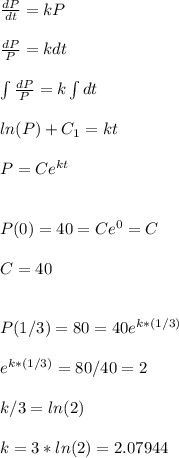
Mathematics, 17.03.2020 04:34, HernanJe6
A common inhabitant of human intestines is the bacterium Escherichia coli, named after the German pediatrician Theodor Escherich, who identified it in 1885. A cell of this bacterium in a nutrient-broth medium divides into two cells every 20 minutes. The initial population of a culture is 40 cells. (a) Find the relative growth rate. k = hr−1 (b) Find an expression for the number of cells after t hours. P(t) = (c) Find the number of cells after 7 hours. cells

Answers: 1
Other questions on the subject: Mathematics

Mathematics, 21.06.2019 12:40, lokiliddel
Given the graph below state whether or not the relation is a function, and give the domain and range.
Answers: 3

Mathematics, 21.06.2019 15:20, queentynaisa
Which is the equation of an ellipse with directrices at x = ±4 and foci at (2, 0) and (−2, 0)?
Answers: 3

Mathematics, 21.06.2019 20:10, kingdrew27
Acolony contains 1500 bacteria. the population increases at a rate of 115% each hour. if x represents the number of hours elapsed, which function represents the scenario? f(x) = 1500(1.15)" f(x) = 1500(115) f(x) = 1500(2.15) f(x) = 1500(215)
Answers: 3
Do you know the correct answer?
A common inhabitant of human intestines is the bacterium Escherichia coli, named after the German pe...
Questions in other subjects:








Chemistry, 04.07.2019 21:50

History, 04.07.2019 21:50

Social Studies, 04.07.2019 21:50









